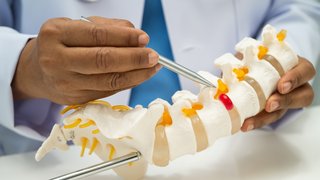3D bunion surgery gets you back on your feet faster
April 23, 2021

Bunions are much more than a cosmetic issue caused by wearing high heels or shoes that are too tight. Hallux valgus, more commonly referred to as a bunion, is a structural deformity in the foot that causes a bony bump to form at the base of the big toe.
Painful and potentially dangerous, bunions can affect your balance and gait, and even lead to falls in older adults.
The root cause of bunions can be instability in the midfoot joint, which forces the first metatarsal, or big toe, to move. As surrounding bones in the foot shift out of alignment to accommodate the instability, the joint at the base of the big toe begins to deviate out at a 45-degree angle, while the tip of the toe points toward the rest of the toes. The result is inflammation and pain from imbalanced weight-bearing and friction against footwear.
Left untreated, bunions increase pressure on the bursa – the fluid sac that pads the bones near the big toe – causing a condition called bursitis that causes swelling and pain. In severe cases, the bursa can rupture and become infected.
Unfortunately, bunions are a very common foot deformity. Studies show approximately one-third of U.S. adults deal with this often-painful condition, which can be genetic and tends to get worse with age. Women develop bunions more often due to uncomfortable but trendy footwear, such as boots and heels with pointed toes.
While cosmetic surgeries can change the way a bunion looks, sheering down the protruding bone won't prevent the bothersome bulge from returning. Research shows that 50 to 78 percent of bunions return if the root cause is not addressed.
To truly fix a bunion, we must correct the soft tissue and bony structure abnormalities that caused the protrusion in the first place. And to do that, we offer lapiplasty bunionectomy – an innovative foot surgery that addresses bunions in three dimensions, realigning the bone and dramatically reducing the recovery time and risk of recurrence.
UT Southwestern is an investigation site for the ALIGN3D clinical trial, which wraps up in December 2021. We are tracking results for patients who bear weight just a few days after lapiplasty versus six to eight weeks following traditional bunion surgery. Our goal is to improve patient outcomes and further reduce recurrence.
Of course, not every patient with bunions needs surgery. Depending on your anatomy and activity level, nonsurgical treatments may be enough to manage mild or moderate pain.
But if bunions have reduced your mobility or quality of life, talk with your doctor about treatment options to see whether lapiplasty could be the solution to getting you moving again.
Related reading: UT Southwestern researchers identify risk factors for unsuccessful bunion surgery
How lapiplasty corrects bunions in 3D
Lapiplasty represents a significant improvement on traditional bunion removal surgery, or lapidus, which addresses the bunion from a two-dimensional perspective (sideways and elevated).

With lapidus, the protruding metatarsal bone – which connects the midfoot to the big toe – is cut in half vertically and shifted inward. Then, we fuse between the first metatarsal bone and one of the small bones in the midfoot, correcting the original deformity and allowing the toe to stay straight.
Often, though, the bunion develops because the metatarsal is misaligned in three dimensions: sideways, elevated, and rotated out of alignment. A lapiplasty bunionectomy allows us to address the bunion in 3D. We don't cut the metatarsal with this procedure. Instead, we rotate it back to its normal anatomical position, naturally removing the bunion.
Lapiplasty bunionectomy cuts time-to-weight-bearing down to just days. Most patients can walk within 48 hours of surgery, protected in a boot, compared with six to eight weeks after traditional surgery. And many can start wearing their favorite footwear again within a few weeks – even heels. After the patient's bones are fully healed, they can resume the sports and exercise that bunion pain kept them from enjoying.
In lapiplasty, we use specially designed instruments to rotate the bone back into alignment from all dimensions – straightening the toe and naturally removing the bump. We then fuse the bones together at the tarsometatarsal joint, and secure the joint with titanium plating technology. You won't permanently lose range of motion in your toe. The first metatarsal will continue to move normally, and the big toe will stay straight, decreasing the risk of the bunion returning.
The plates applied during a lapiplasty enable patients to bear weight on their foot – with the assistance of a boot – within days or a week, instead of many weeks. Because it takes time for the bone and soft tissue to heal, you won’t regain normal range of motion until about six months, but until then, you will be mobile!
Meet Dr. VanPelt
A Doctor of Podiatric Medicine, Michael VanPelt specializes in treatment of foot and ankle sports injuries in adolescent and adult athletes, as well as foot and ankle trauma and reconstruction.
Surgical experience matters
UT Southwestern is at the forefront of advanced foot and ankle surgery. In the Department of Orthopaedic Surgery, our team of foot and ankle specialists are nationally recognized and perform multiple lapiplasty bunionectomies each week.
We also regularly see patients who need revisional surgery and relief after poor outcomes from bunionectomies at low-volume centers. But we don’t always recommend surgery.
Depending on your condition, we may first suggest nonsurgical options, which can help reduce pain and keep a mild or moderate bunion from getting worse.
If these treatments no longer work to manage your pain, you may need surgery:
- Footwear changes: Find footwear that fits properly and does not compress the toes. Women are more likely to get bunions because they tend to wear tight, narrow shoes that squeeze their toes together.
- Medication: Nonsteroid anti-inflammatories such as ibuprofen can help relieve pain and reduce swelling. If your bunion is caused by arthritis, your doctor may prescribe a medication.
- Orthotics: Over-the-counter or custom-made shoe inserts or toe spacers may help relieve pain.
- Padding the bunion: Protective padding can cushion the inflamed bump. But in some cases, padding may increase the pressure on the bunion and make the pain worse.
Don’t dismiss bunions as a minor or merely unsightly problem. They can take a toll on your mobility, balance, and self-esteem. If painful bunions are interfering with your daily life, talk with your doctor about lapiplasty to see whether it is the best solution for you.

Schedule an Appointment Now with Michael VanPelt, D.P.M.
Existing patients may also schedule an appointment using MyChart.
Orthopaedic Surgery Clinic (Dallas)
1801 Inwood Road, 1st Floor, Dallas, Texas 75390
Additional Office Locations
Dr. VanPelt’s additional office locations do not accept online scheduling.
To make an appointment at one of Dr. VanPelt’s other locations, please use the Request an Appointment button below and fill out form that follows.











